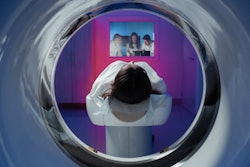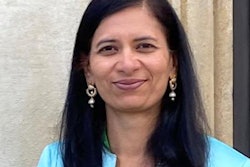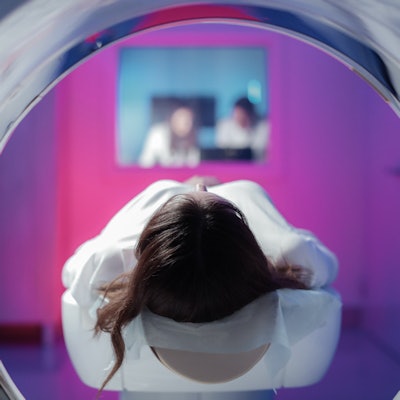
The U.K. is currently short of 1,669 clinical radiologists, and over 200 vacancies have been unfilled for a year or more, according to the annual census released on 9 June by the Royal College of Radiologists (RCR). Unless urgent action is taken, the shortfall could hit 39% by 2026, equal to 3,166 clinical radiologists, the report says.
These shortfalls are directly impacting patient safety and staff morale, and the strain of working under high levels of pressure is taking its toll on doctors, the authors wrote. Almost all clinical directors said they are concerned about the backlogs and delays patients are facing on a daily basis, while 98% said they are concerned about workforce stress and burnout in their departments.
"Everyone is very highly pushed and only just coping," said one respondent.
"We have an exhausted workforce, low morale and we're losing faith in senior management. We have constant complaints regarding delayed appointments and reporting turnaround from both patients and consultant colleagues within the NHS (National Health Service) trust," noted another clinical director.
The current picture
The total number of U.K. whole-time equivalent (WTE) consultant radiologists has increased by 225 consultants (6% of the workforce) from 3,902 in 2020 to 4,127 in 2021. More consultants have entered the clinical workforce, but it is not enough to address the overall shortfall.
As the chart below shows, the shortages are particularly acute in Wales and England, but the prospects for the future are markedly worsening in all four nations.
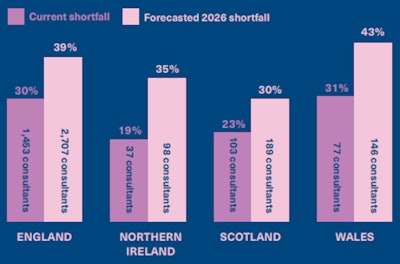 The situation facing Wales and England is particularly tough. All figures courtesy of the RCR.
The situation facing Wales and England is particularly tough. All figures courtesy of the RCR.The number of U.K. interventional radiologists has grown, with a further 43 consultants (6% growth) appointed over the past year, but the increase is not enough to address the overall shortfall, which is estimated at 28% (288 WTE radiologists).
The funded vacancy rate is still high at 10% (436) of available clinical radiology posts, and this figure has remained relatively unchanged over the past five years, according to the RCR.
In 2021, Northeast England experienced the highest vacancy rate at 17%. There are some positives to highlight on a national level, with Scotland's 12% and Wales' 10% vacancy rates in 2020 both dropping to 8%, but the rate for Northern Ireland rose from 8% to 13%.
Overseas recruitment and outsourcing
The report also highlights the U.K.'s growing reliance on international consultant radiologists (CRs). The percentage of doctors who obtained their primary medical qualification outside of the U.K. increased from 29% in 2016 to 35% in 2021.
Over the same five-year period, 67% of CRs joining the workforce were trained in the U.K., and 33% were recruited globally. Of these, just over a third came from India, and the proportion of non-European Economic Area radiologists rose from 20% in 2016 to 25% in 2021.
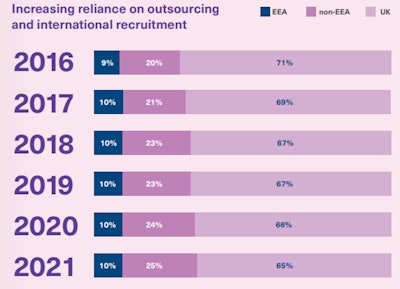 U.K. radiology has become increasingly dependent on recruitment from outside of Europe.
U.K. radiology has become increasingly dependent on recruitment from outside of Europe.As one clinical director put it: "We are having to pay agencies to find staff from overseas which comes with a large finder's fee and often the radiologists then need considerable input to get them up to speed, with no guarantee that they will stay."
Outsourcing to the independent sector continues to fill gaps, along with insourcing (overtime) and ad hoc locums, the RCR report states. U.K expenditure on these resources more than doubled between 2016 and 2020, reflecting worsening staff shortages going into the pandemic.
Wake-up call for government
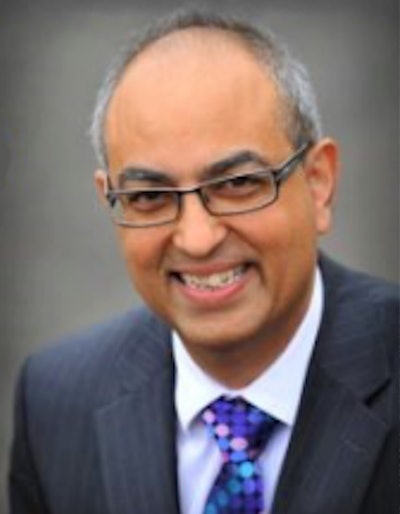 Dr. Raman Uberoi.
Dr. Raman Uberoi.The report "should provide a stark wake-up call to government and the NHS as to the scale of workforce shortages and the impact they have," Dr. Raman Uberoi, RCR's medical director for professional practice, clinical radiology, wrote in a strongly worded foreword to the document.
Unless urgent action is taken, workforce shortages will worsen, he noted. "This needs to be addressed urgently, along with strategies for enabling more clinicians to continue working after retirement age."
Tackling workforce issues -- whether through training more doctors or establishing new ways of working -- requires time and resources at a time when clinicians are facing unprecedented pressure, Uberoi continued. The crisis demands a holistic approach to ensure the U.K. doesn't lose more doctors to burnout than what it can recruit and train.
"If the picture appears bleak, that is because it is, and action is needed urgently," Uberoi said.
The RCR is calling for long-term investment into the workforce, including a sustained increase in trainee numbers, a clear strategy for global recruitment and outsourcing, and a focus on doctor retention, particularly for those approaching retirement.
"Failure to tackle these issues will inevitably lead to unacceptable wait times and, ultimately, poorer outcomes for patients," Uberoi concluded.
A free copy of both the clinical radiology and oncology census reports is available via the RCR website.






